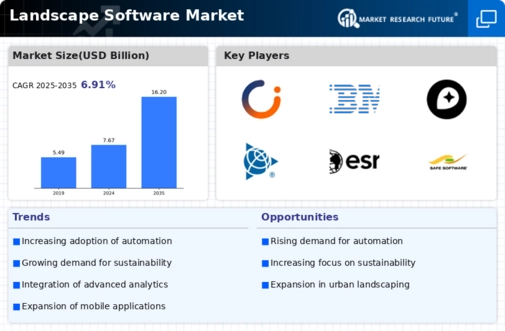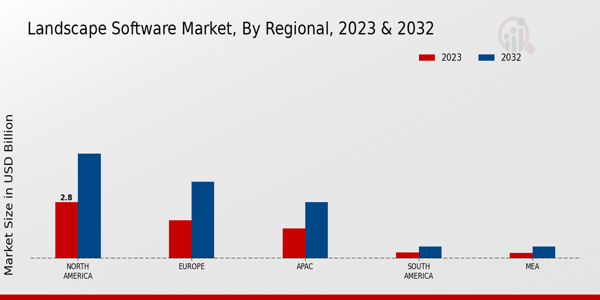Market Growth Projections
The Global Landscape Software Market Industry is projected to experience substantial growth, with estimates indicating a rise from 7.67 USD Billion in 2024 to 16.2 USD Billion by 2035. This growth trajectory suggests a compound annual growth rate of 7.02% from 2025 to 2035. Such projections highlight the increasing reliance on software solutions in landscape design and management, driven by factors such as technological advancements, urbanization, and sustainability initiatives. The anticipated market expansion underscores the industry's potential to adapt to evolving consumer needs and preferences.
Rising Demand for Sustainable Practices
The Global Landscape Software Market Industry experiences a notable increase in demand for sustainable landscaping practices. As environmental concerns grow, landscape professionals increasingly seek software solutions that facilitate eco-friendly designs and resource management. This shift is evident in the adoption of tools that optimize water usage and promote native plant selections. The industry's focus on sustainability aligns with global initiatives aimed at reducing carbon footprints, which is likely to drive the market's growth. By 2024, the market is projected to reach 7.67 USD Billion, reflecting the industry's commitment to integrating sustainability into landscape design.
Growing Interest in Landscape Aesthetics
The Global Landscape Software Market Industry is significantly influenced by the increasing interest in landscape aesthetics among property owners and developers. As outdoor spaces become extensions of living areas, there is a heightened demand for visually appealing designs. Landscape software provides tools for creating detailed visualizations, enabling clients to envision their projects before implementation. This trend is particularly evident in residential and commercial developments, where attractive landscapes can enhance property value. The industry's growth trajectory suggests that this focus on aesthetics will continue to drive software adoption, contributing to a market value of 7.67 USD Billion by 2024.
Expansion of Educational and Training Programs
The expansion of educational and training programs in landscape architecture and design is a notable driver for the Global Landscape Software Market Industry. As more institutions incorporate landscape software into their curricula, a new generation of professionals emerges with proficiency in these tools. This trend not only increases the overall demand for landscape software but also fosters innovation as fresh ideas and techniques are introduced. The emphasis on practical training ensures that graduates are well-equipped to meet industry demands, potentially leading to a more robust market. The anticipated growth to 16.2 USD Billion by 2035 reflects this educational impact.
Technological Advancements in Software Solutions
Technological innovations play a pivotal role in shaping the Global Landscape Software Market Industry. The integration of advanced technologies such as artificial intelligence, augmented reality, and geographic information systems enhances the functionality of landscape software. These advancements enable landscape architects and designers to create more accurate and visually appealing designs. For instance, AI-driven tools can analyze site conditions and suggest optimal plant placements. As these technologies evolve, they are expected to attract more users, contributing to a projected market growth to 16.2 USD Billion by 2035, indicating a robust trajectory for the industry.
Increased Urbanization and Infrastructure Development
Urbanization and infrastructure development are key drivers of the Global Landscape Software Market Industry. As cities expand, the need for efficient landscape planning and management becomes paramount. Landscape software assists urban planners in designing green spaces that enhance urban aesthetics and improve residents' quality of life. The growing trend of incorporating parks and recreational areas in urban settings underscores the importance of landscape design. This demand is likely to propel the market forward, with a projected compound annual growth rate of 7.02% from 2025 to 2035, highlighting the industry's responsiveness to urbanization trends.

















